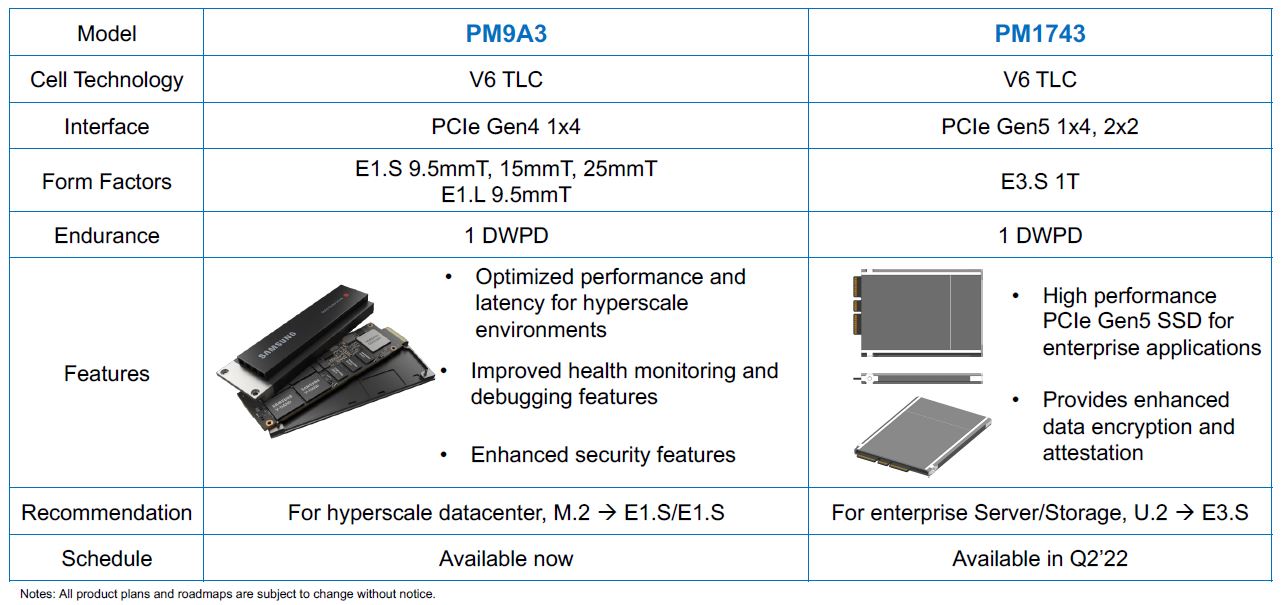Samsung Teases PCIe 5.0 SSDs: Coming in Q2 2022
Samsung's PM1743 PCIe Gen 5 SSD incoming.
Samsung has published some preliminary details about its enterprise-grade SSDs featuring a PCIe 5.0 x4 interface. The drives will be available in an E3.S 1T form-factor within a year, just in time for the first PCIe 5.0-supporting enterprise platforms, like AMD's EPYC Genoa and Intel's Sapphire Rapids, to hit the market.
Samsung's PM1743 solid-state drive will be based on the company's proprietary controller as well as 6th Generation TLC V-NAND memory, reports ServeTheHome. The SSD is rated for up to one drive writes per day (1 DWPD) and is designed for mixed workloads.

The Samsung PM1743 drive will feature a PCIe Gen 5 x4 (single-port) or dual x2 (dual-port) interface and will come in an E3.S 1T form-factor (111.5 mm × 31.5 mm (L×W) designed to increase storage density in a server. There is no word about performance of the PM1743, but theoretical peak throughput for a PCIe 5.0 x4 interface is about 15.7 GB/s.
In any case, the PM1743 should be faster than the PM9A3, which is designed for data center applications and which is one of Samsung's fastest PCIe 4.04 x4 SSDs. It offers up to 6800 MBps sequential read speed. As for power consumption, an E3.S 1T drive can consume up to 25W of power.
Nowadays, most SSDs designed for enterprise and mission-critical applications (including those from Samsung) come in a 2.5-inch form-factor with a SAS or U.2 interface. Meanwhile, some drives also come in an add-in-card form-factor and use a PCIe 3.0/4.0 x8 interface. With an EDSFF E3 form-factor, Samsung and other makers of SSDs will be able to increase the capacity of their drives and enable higher storage density of next-generation servers running AMD's Genoa and Intel's Sapphire Rapids processors.
It is noteworthy that Samsung plans to use its 7th Generation 176-layer V-NAND memory for its PCIe Gen 5 SSDs designed for client PCs, but no announcements have been made about availability.
Get Tom's Hardware's best news and in-depth reviews, straight to your inbox.

Anton Shilov is a contributing writer at Tom’s Hardware. Over the past couple of decades, he has covered everything from CPUs and GPUs to supercomputers and from modern process technologies and latest fab tools to high-tech industry trends.
-
mdd1963 Given the impact of jumping to PCI-e 4.0 drives, I fully expect this PCI-e 5.0 generation to shave another full 0.21 seconds from WIndows boot times! :)Reply -
hotaru251 wow TLC even?Reply
5.0 drives skipping mlc and slc entirely.
also unless ppl step up game these fast specs wont matter if the rest of your pc cant use all of the prior protocol. -
salgado18 Reply
In a couple years, SSD performance will be one of the bottlenecks for gaming performance, just like the GPU and CPU are. See the Unreal demo that loads everything from disk in real time, and the current gen consoles that require a fast SSD.mdd1963 said:Given the impact of jumping to PCI-e 4.0 drives, I fully expect this PCI-e 5.0 generation to shave another full 0.21 seconds from WIndows boot times! :)